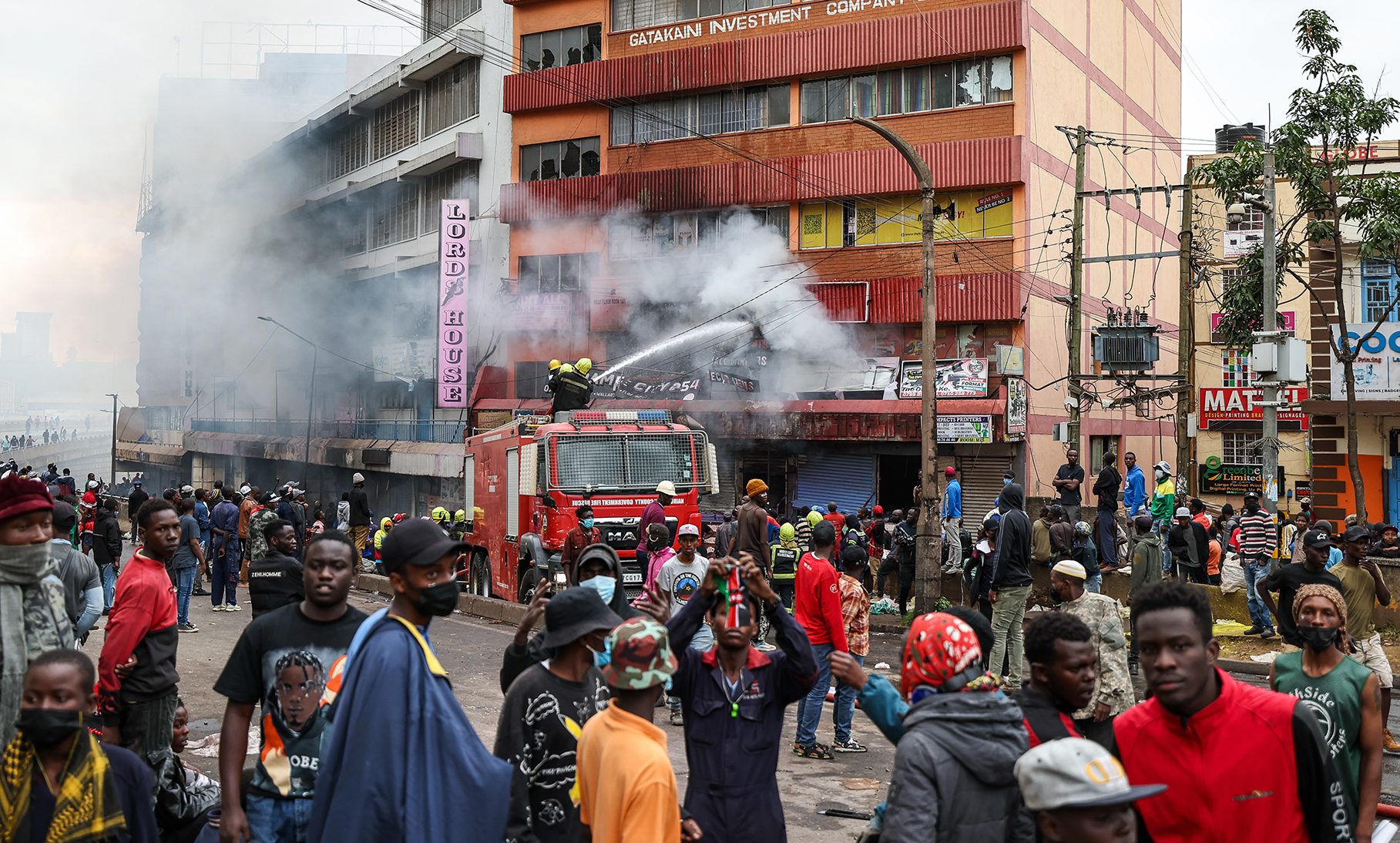Kenya is caught in a spiral of violence in which protests against corruption, misgovernance and police brutality spark further police brutality and these, in turn, inspire further protests.
Underlying this feedback loop is a deep and abiding malaise felt mainly by young people over their deteriorating living conditions and prospects.
Wednesday’s demonstrations, in which at least 16 people died in the capital, Nairobi, and elsewhere in the country, were held mainly to commemorate the violent suppression of anti-tax protests a year ago when about 60 people were killed. Those protests peaked on 25 June 2024 when protesters stormed the parliament while MPs inside passed legislation to raise taxes.
This week’s anniversary marches started peacefully but then turned violent with protesters engaging in running battles with the police, who fired tear gas and barricaded government buildings with barbed wire.
/file/dailymaverick/wp-content/uploads/2025/06/13148953.jpg)
The demonstrators were also protesting at the death of the teacher Albert Ojwang in police custody this month after he accused on social media the country’s deputy police chief, Eliud Lagat, of corruption. Some were also protesting against the police shooting of the vendor Boniface Kariuki at close range during a protest over Ojwang’s death.
President William Ruto’s government ordered TV and radio stations to stop live broadcasts of the protests to try to defuse them. When the TV stations NTV, KTN, K24 and Kameme refused to do so, they were taken off air.
“We face an unfortunate paradox as a country where more lives are being lost as the people seek justice for the lives already lost,” said the Law Society of Kenya’s president, Faith Odhiambo, on X. “Our hearts break for all the victims of the continued trend of police brutality and excesses.”
But the demonstrators, mostly young, are also expressing a growing frustration at corruption, unemployment and rising living costs.
The major protests of a year ago were provoked by Ruto’s introduction of a Bill to substantially increase taxes to balance the government’s books. The unexpectedly vigorous protests eventually persuaded him to withdraw the Bill. Some Kenyan analysts say he surreptitiously dispersed the tax increases in other legislation.
However, the imminent national Budget for this year is expected to focus on increasing tax revenue via higher compliance rather than imposing new taxes, according to Africa Confidential.
Although protests peaked last year over Ruto’s tax hike, street demonstrations continued intermittently. On 12 June, police used tear gas to disperse crowds which had gathered near the National Assembly to protest at Ojwang’s killing and attempts by the police to cover it up.
And abductions and disappearances of government critics continued.
/file/dailymaverick/wp-content/uploads/2025/06/13131509.jpg)
Strangled
The police initially claimed that Ojwang (31) had died from “hitting his head against a cell wall”, implying that he had committed suicide. But a postmortem showed he had been strangled and beaten to death. On 11 June, Ruto admitted that Ojwang had been killed “at the hands of the police” and described the killing as “heartbreaking and unacceptable”.
The same day, Inspector-General Douglas Kanja apologised to the National Assembly for saying that Ojwang’s injuries had been self-inflicted. That day too, the Independent Policing Oversight Authority chairperson, Ahmed Issack Hassan, told a National Assembly committee that there had been “20 deaths in police custody in the last four months”.
On Tuesday, prosecutors charged six people, including three police officers, for their role in killing Ojwang. But the move did not satisfy protesters, who complained that the three officers were taking the rap for Deputy Police Chief Lagat, who they believed was responsible for Ojwang’s death.
Some analysts believe Ruto’s decision to acknowledge that the police were guilty was an encouraging if somewhat belated sign of accountability on his part. Others believe it was a sign of his anxiety about the growing protests and the need to deflect them, rather than evidence of genuine penitence.
That it has taken so long for Ruto to finger the police suggests complicity in their previous excesses.
/file/dailymaverick/wp-content/uploads/2025/06/GettyImages-2171721407.jpg)
One analyst, who did not wish to be named, said high unemployment, the disproportionate and violent police response, and the abductions and disappearances of government critics were radicalising young Kenyans. He noted that 60% of the population was under 25, and 75% under 35.
“Their grievances are legit. They need their country to work, yet Ruto is not doing the bare minimum to make the country work. He keeps shooting himself in the foot with ‘reforms’ that really ignore country context.”
Protesters also felt that Ruto had lied to quell last year’s protests with cosmetic reforms, such as firing the Cabinet, yet returning most of the ministers to office; withdrawing the finance Bill; and surreptitiously sneaking the bad proposals into other Bills.
The protesters were also not convinced by Ruto’s stratagem of bringing his erstwhile political rival, Raila Odinga, into a broad-based government.
“In short, Ruto squandered public trust and the political capital with which he came to power [in 2023] and now he believes using fiat and force, and increased surveillance will manage the country.
“He keeps on applying Band-Aid, while the young people, most of them who have already given up, want him to do the right thing. He threatens to kill them, and they tell him they are ready to be martyred,” said the analyst. DM




 Firefighters battle a fire alleged to have been started by tear gas canisters that exploded as Kenyan policemen tried to disperse demonstrators during a protest in the central business district of Nairobi on 25 June. (Photo: Daniel Irungu / EPA-EF)
Firefighters battle a fire alleged to have been started by tear gas canisters that exploded as Kenyan policemen tried to disperse demonstrators during a protest in the central business district of Nairobi on 25 June. (Photo: Daniel Irungu / EPA-EF)